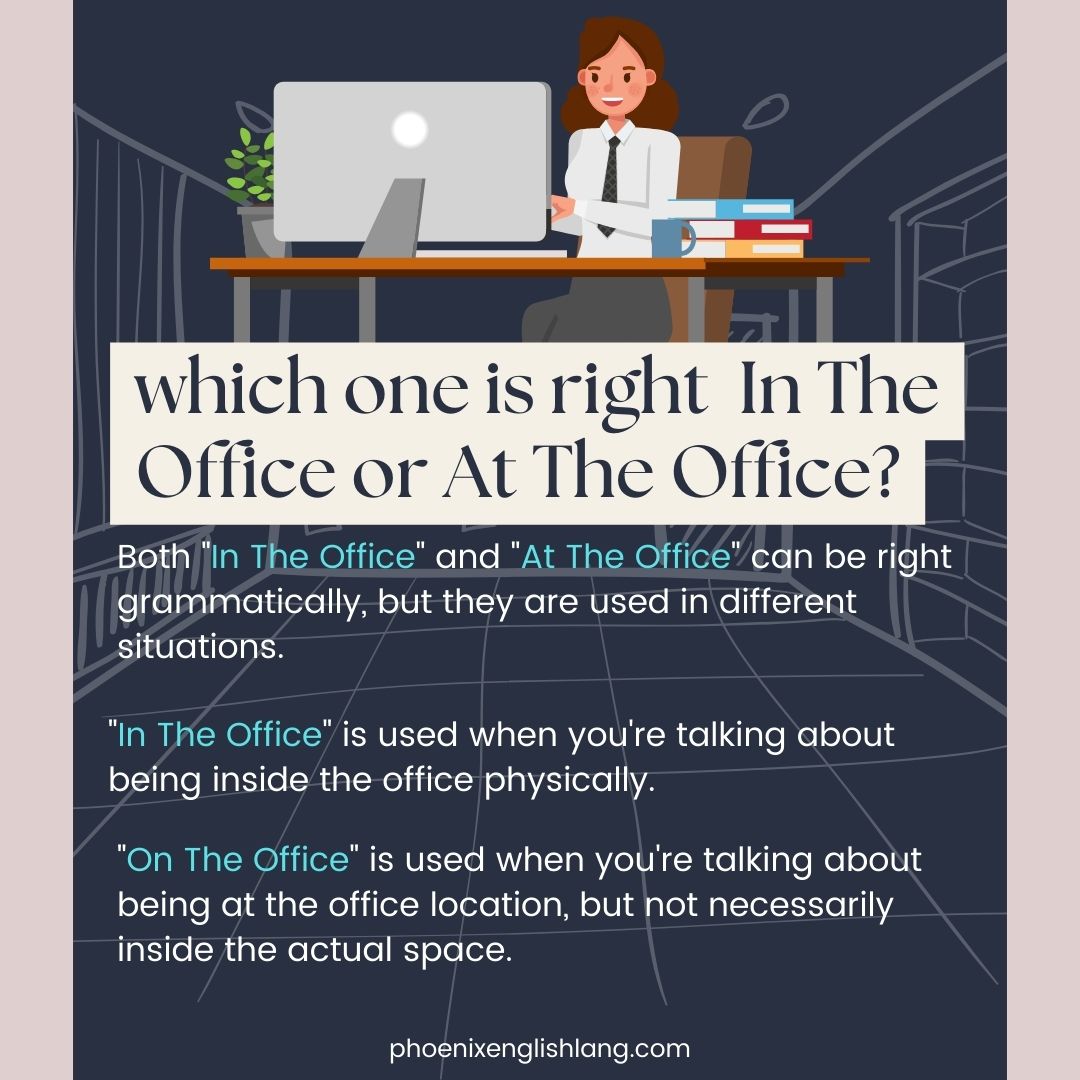In today’s work scene, the difference between working “in the office” and working “at the office” has become more important.
This article looks at the seven main differences between these two ideas, giving insight into how workplace settings are changing in 2023.
which one is right – In The Office or At The Office? What’s the main answer?

Both “In The Office” and “At The Office” can be right grammatically, but they are used in different situations.
“In The Office” is used when you’re talking about being inside the office physically. For example, “I’m in the office right now.”
“On The Office” is used when you’re talking about being at the office location, but not necessarily inside the actual space. For example, “I’m waiting for you on the office premises.” The correct answer depends on the specific situation where the question is asked.
You might also enjoy: Trainer or Trainor: 10 Main Differences + Examples [2023]
1. Physical Presence of In The Office or At The Office:

The difference between “In The Office” and “At The Office” is all about where you are physically.
Both phrases are correct, but they mean different things depending on the situation.
When we say “In The Office,” we mean we’re inside the office space. It means we’re actually in the office building or workspace.
It suggests that we’re actively doing work in that specific place. For example, an employee might say, “I am in the office right now, working on a project.”
This phrase emphasizes that they’re physically present in the office environment.
On the other hand, “At The Office” means you are at the office, but not necessarily inside.
It just means you are near or on the office grounds. It doesn’t say if you’re inside or working.
For example, someone might say, “I am at the office, waiting for a meeting to start.” Here, it’s about where you are, not if you’re inside the building.
If you want to say you’re physically in the office, then say “In The Office.” But if you just want to say you’re at the office without getting into specifics, then say “At The Office.”
It’s important to remember that this might change depending on where you are and what culture you’re in.
Sometimes people use both phrases interchangeably. So always think about the context and what you really mean when you pick between “In The Office” and “At The Office.”
“In The Office” and “At The Office” are both cool ways to say it, but they kinda mean different things.
“In The Office” is like being inside the actual office space, while “At The Office” is just being at the office place without getting into specifics.
2. Commuting of In The Office or At The Office :
Commuting to work is something a lot of people do every day. When we talk about where we work, we use the phrases “In The Office” and “At The Office” to describe the commuting experience.
“In The Office” means actually being inside the office building. It means you’ve arrived at your workspace and you’re working. Commuting “In The Office” means going to the office and then working inside.
“On The Office” is used to describe being at the office location, but not necessarily inside the physical workspace.
This phrase is about everything around the office, like the building, parking lot, or nearby stuff.
Commuting “On The Office” means reaching the area around the office, which could include parking, going inside the building, or waiting in certain spots.
Choosing between “In The Office” and “At The Office” depends on the specific context and how much detail you want to give.
If you want to focus on physically being inside the workspace, then “In The Office” is the way to go.
But if you want to talk about the whole office location, including the surrounding area, then “At The Office” is the better phrase.
It’s important to know that both phrases are grammatically correct, but which one you use depends on what you’re talking about.
3. Collaboration of In The Office or At The Office :

Collaboration is super important when you work in an office. You can collaborate either “In The Office” or “At The Office,” depending on what you’re talking about.
When we say collaboration “In The Office,” we mean working together with your coworkers in the actual office space.
This includes talking face-to-face, having meetings as a team, coming up with ideas together, and doing other collaborative stuff in the office.
Being “In The Office” means you can talk to each other right away and share ideas in real time. On the other hand, collaboration “At The Office” is a bigger picture.
It’s about collaborating even when you’re not physically in the office. This can mean working together from different places using different tools and technology.
It could also involve working together with people from outside, like clients or partners, who may not be physically here in the office but still part of the team.
The choice between saying “In The Office” and “At The Office” when talking about working together depends on the specific situation and the type of collaboration being talked about.
If the focus is on interacting in person and teamwork within the office, then “In The Office” is the right phrase.
But if the collaboration is bigger, like including remote work or working with external partners, then “At The Office” is a better choice.
In the end, effective collaboration can happen both “In The Office” and “At The Office,” as long as there are good ways to communicate and tools to help with teamwork and cooperation.
You might also enjoy: Thanks God or Thank God – Fully Explained + Video
4. Office Infrastructure of In The Office or At The Office :
The office setup is super important in making sure everyone can work well and efficiently.
When we talk about the office setup, the phrases “In The Office” and “At The Office” mean different things about the physical space and what’s available.
“In The Office” means the inside area where employees do their work. It has lots of stuff like desks, meeting rooms, cubicles, and shared spaces.
The office setup “In The Office” has stuff like desks, chairs, computers, phones, and other things we need.
It also includes things like printers, scanners, and office supplies that help us with the day-to-day work.
And sometimes, “In The Office” can have special areas like meeting rooms, break rooms, or spaces where we can work together as a team.
“On The Office” is all about the physical location of the office, like the building and the area around it.
It includes stuff like the outside design, parking, entrances, and security. The office setup “On The Office” has things like parking lots or garages, systems to control who gets in, reception areas, and the lobby.
It also includes things like cafeterias, gyms, or outdoor areas that make the whole working environment better.
Whether we say “In The Office” or “At The Office” depends on what exactly we’re talking about in terms of the office setup.
If you’re talking about what’s inside the office and all the cool stuff you can find there, then you should say “In The Office.”
This includes things like how the office is set up, the furniture, the equipment, and all the things that make the employees’ work experience better.
On the other hand, if you’re talking about the physical location of the office and all the cool stuff around it, you should say “At The Office.”
This includes things like the whole building, the parking, the security, and all the extra stuff that makes the office environment great.
To sum it up, “In The Office” and “At The Office” mean different things when we’re talking about the office.
“In The Office” is all about the inside of the office and what’s in it, while “At The Office” is about the location and everything around it. Both things are important for making a good work environment for the employees.
5. Distractions of In The Office or At The Office:

distractions can be a real problem for people working in both “In The Office” and “At The Office.”
The kind of distractions you face might be different, but they can really mess with your ability to get stuff done.
When you’re “In The Office,” distractions can come from all sorts of things in your actual workspace.
Your coworkers might be having conversations, making phone calls, or having meetings nearby, and that can totally throw you off.
Plus, you’ve got office equipment like printers, scanners, and copiers that can be loud or need fixing, which just adds to the interruptions.
And let’s not forget about open office layouts – they make it super easy to get distracted by all the things you see and hear around you.
On the other hand, when you’re working “At The Office,” distractions can come from the environment around you.
External stuff like traffic noise, construction stuff, or even weather conditions can mess with your focus.
And if your office is in a shared building or complex, noise from other businesses or common areas can also be a major distraction.
Plus, if you don’t have a dedicated workspace or you have personal stuff to take care of at home, that can also make it hard to concentrate when working remotely.
But whether you’re “In The Office” or “At The Office,” there are a few things you can do to deal with distractions.
One is to set clear boundaries and let your colleagues know what you need. Another is to use noise-cancelling headphones or find a quieter spot in the office.
And you can also try managing your time better by scheduling blocks of uninterrupted work.
Finally, organizing and tidying up your workspace can help you stay focused by reducing visual distractions.
When you’re working remotely “At The Office,” it’s super important to have a dedicated workspace that’s separate from your personal stuff.
This helps you mentally separate work from your personal life and makes it less likely that you’ll get distracted.
Also, setting up a comfy and ergonomic workspace can help you stay focused and get more done.
And if you use tools like productivity apps or website blockers, you can limit distractions from social media or websites that have nothing to do with work.
Whether you’re working “In The Office” or “At The Office,” managing distractions is all about self-discipline, good communication, and creating an environment that’s all about getting stuff done.
When you use strategies to minimize distractions, you’ll be more productive and able to stay focused on your work, which means you’ll get more done and be successful.
You might also enjoy: Full List Of Words That End In Do [2023]
6. Work-Life Integration of In The Office or At The Office:
Work-life integration is all about blending your work and personal life together, so it’s more flexible and harmonious.
When we talk about “In The Office” and “At The Office” in the context of work-life integration, they really define the boundaries and how things work.
“In The Office” means physically being in the office space. It’s more like the traditional way of working, where you separate your work and personal life.
The focus is on being in your designated workspace, working specific hours, and keeping work and personal time separate.
This approach gives you a routine and keeps work and personal life separate. But, Work isn’t just limited to the office.
You can work from different places. It’s all about being flexible and working remotely.
You can still be productive and involved in your work even if you’re not in the traditional office.
This way of working lets you blend your work and personal life more easily. It helps you manage your commitments and responsibilities better.
Both “In The Office” and “At The Office” have their good points when it comes to work-life balance.
It depends on what you prefer, what your job needs, and how much freedom you have at your company.
The main goal of work-life balance is to find a sustainable and fulfilling mix of work and personal life. You should be able to do well in both areas and take care of yourself.
7. Company Culture of In The Office or At The Office:

The idea of company culture is all about the stuff that makes a workplace feel like a community.
It’s not just about being “In The Office” or “At The Office,” because company culture goes beyond the physical location.
Company culture includes a bunch of things like the organization’s mission, vision, and core values, as well as how people talk to each other, how the bosses lead, how the team works together, and how the company keeps the employees engaged.
It affects how people interact, how decisions get made, and how everyone feels about the work environment. While the actual office space can have an impact on company culture, it’s not the only thing that matters.
There are lots of ways to build company culture, like doing team-building activities, having training programs, giving recognition and rewards, and keeping the communication open.
When it comes to making a good work environment, it’s all about creating a positive and inclusive vibe where everyone works together, comes up with new ideas, and feels good.
To really understand what a company is like, you can’t just look at where the office is. You have to see how the people there interact, how much they trust each other, what chances they have to grow and get better, and what it’s like to work there overall.
So when you talk about company culture, it’s better to think about the values, things they do, and how they act as a whole, rather than just saying “In The Office” or “At The Office.”
You might also enjoy: Revise Vs Review: 9 Differences + Examples [2023]
Which is correct in office or at office?
Both “in office” and “at the office” are correct, but they are used in different contexts.
“In office” is used to indicate that someone is currently working at their place of employment, such as in the following sentence: “She is in office today, working on the new project.”
“On the other hand, “at the office” is used to refer to the physical location of someone’s workplace, as in: “I left the documents at the office.”
So, the choice between “in office” and “at the office” depends on whether you are referring to someone being present and working at their workplace or simply indicating the location of the workplace itself.
When would you use “in office” and when would you use “at the office”?
“In office” and “at the office” are both prepositional phrases used to indicate someone’s location or presence in relation to their workplace. The usage depends on the context and the specific information being conveyed.
“In office” is used to indicate that someone is currently working at their place of employment. It typically implies that the person is actively working in their capacity as an employee or in an official capacity. For example:
– “The manager is in office today, working on the budget report.”
– “I will be in office until 5 PM to address any urgent matters.”
“At the office” is used to refer to the physical location of someone’s workplace or to indicate where something is located within the workplace. It is more about specifying a place. For example:
– “I left my laptop at the office.”
– “The meeting will take place at the office conference room.”
In summary, “in office” emphasizes the presence and activity of the person at their workplace, while “at the office” refers to the location of the workplace or the presence of an object within that location.
How does the context influence whether to use “in office” or “at the office” in a sentence?
“In office” is typically used to refer to someone currently holding a political position or job, while “at the office” is more commonly used when indicating someone’s physical presence at their workplace.
Consider the context and whether you are discussing a person’s role or their location to choose between the two phrases.
In there a difference in formal or informal contexts when using “in office or “at the office
Both “in office” and “at the office” can be used in both formal and informal contexts, but “in office” is more commonly associated with formal settings when referring to someone holding a position, especially in politics or business.
“At the office” is generally more neutral and can be used in various contexts, both formal and informal, to indicate someone’s physical presence at their workplace.
Conclusion:
As the workplace keeps changing, the differences between working “in the office” and working “at the office” have gotten more complicated.
Both ways have their pros and cons, and companies have to adjust to make a work environment that suits their employees’ needs.
By knowing these key differences, companies can adapt and make the most of productivity, teamwork, and employee happiness in 2023 and beyond.

Hi, welcome to my blog! My name is Omid and I am thrilled to have you here! I am an English language teacher with 12 years of experience and hold multiple international certifications (TESOL, IELTS, TOEFL, PTE, CELTA). Additionally, I hold a PhD in Applied Linguistics with a specialization in Teaching English as a Second Language (TESL), which fuels my passion for teaching English and assisting others in mastering the language. To me, nothing is more rewarding than helping individuals enhance their English language abilities through various methods. So, let’s embark on this journey of learning English together.





